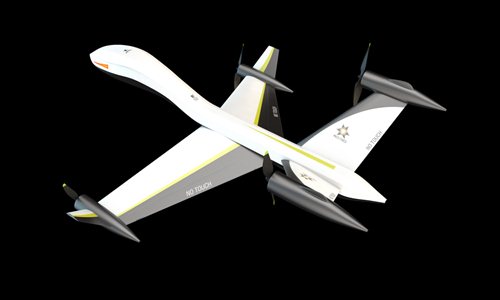
A UAV designed by AOSSCI (Photo/Courtesy of AOSSCI)
Better features put pressure on traditional multi-rotor drones
Move over multi-rotor drones, here comes the fixed-wing unmanned autonomous vehicle (UAV), which is expected to be faster and more stable.
Without doubt, the multi-rotor drone, a mechanically simple aerial vehicle with more than two rotors, has been all the rage for a while now.
The rapid growth of the company DJI can be taken as an instance to reflect on the popularity of such gadgets. The Chinese company, which was founded in 2006 in Shenzhen, the technology and innovation hub of South China's Guangdong Province, accounts for 50.1 percent of drone purchases in the North American market, according to a report issued by US-based market consultancy Skylogic Research LLC in late April.
Given the success of DJI, the multi-rotor market also attracted Chinese tech powerhouse Xiaomi Inc, which showcased its capabilities in the aerial shooting segment with the landing of its drones in late May.
Taking a gamble
While Chinese firms led by DJI are racing to conquer global tech fans and amateur photographers with a slew of dazzling multi-copters, some start-ups in the country are taking a gamble on fixed-wing UAVs.
AOSSCI Technology Ltd, established by a group of unmanned system experts in 2015, is one of the players in the Vertical Take-off and Landing (VTOL) UAV league. The company is set to roll out its VTOL UAV product next month.
Guo Liang, CEO of the start-up with its headquarters in Chengdu, Southwest China's Sichuan Province, acknowledged that multi-rotor drones have rapidly entered the public consciousness thanks to firms' aggressive promotion.
But the development of such gismos has reached a plateau and encountered bottlenecks such as endurance time, cruise speed and payload capacity, Guo told the Global Times on Tuesday.
The latest generation of the DJI Phantom 4 can fly for 28 minutes. This is an increase of 25 percent in comparison with its predecessors the Phantom 3 Professional, according to information on the company's website.
According to Guo, who received his doctorate at the Nanjing University of Aeronautics and Astronautics and continued his post-doctoral research at the University of Electronic Science and Technology of China, a well-designed fixed-wing UAV can fly for a couple of hours by consuming the same battery power.
Unlike multi-rotor drones, VTOL fixed-wing UAVs can take off vertically and then fly like a plane using lift from wings, thanks to the adoption of techniques such as aerodynamics control surfaces coupled with vector thrust.
U.S. tech mammoth Google Inc is also exploring opportunities in the fixed-wing UAV segment.
The company has just recently received the go-ahead from the U.S. Federal Aviation Administration to test its Project Wing delivery services, marking a big step forward for the commercialization of fixed-wing UAVs, which have been widely used in the military sector for years.
Still, Guo noted that the lack of sufficient participants and fairly low recognition by the public are obstacles to commercialization.
"VTOL fixed-wing UAVs require higher technological access than multi-rotor, and most of the relevant engineering software is proprietary, which dampens firms' interests and cannot boost the segment," said Guo.
Out in the open
AOSSCI has planned to set up an open-source project to share major UAV techniques with everyone, especially college students, and encourage people to add any features they want.
The open-source idea has been widely used in the U.S. Internet technology industry.
In 2014, Facebook revealed that it helped 3 million new people access the Internet thanks to its Connectivity Lab, which is doing research on building drones, satellites and lasers based on technologies including from NASA's Jet Propulsion Lab that will occasionally open sources to the public.
It is a wise move for a start-up to build its open-source project at a time when the firm has not enough talents or money to support advanced technology exploitation, Zhu Dalin, an analyst with Beijing-based Analysys International, told the Global Times on Wednesday.
"Such a platform, if it could attract sufficient talented developers, would help fast-track the application of fixed-wing UAVs at the consumer level," said Zhu.
Currently, multi-rotor is the top-selling model among the mass public, given its cheap cost and small size, but users' loyalty appears to be low.
"The multi-rotor on the market is mainly used for photo and video-shooting, which is cool the first time, but does not have a sustainable attraction for us who are not professional photographers," a Beijing-based user of DJI drones surnamed Shi told the Global Times.
Zhu noted that the UAV market is still in its early stages and it is hard to tell which kind of model will become the mainstream of the future drone market.
Only if major players combine UAV with various kinds of traditional businesses and change the way people live can such a gadget fully take off.


















































